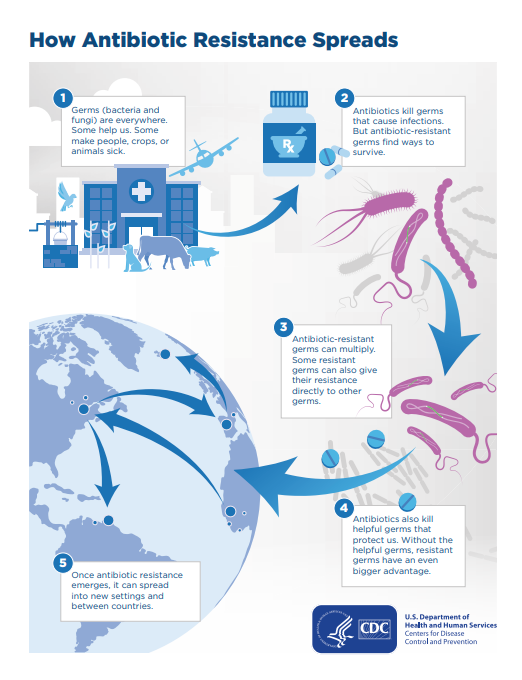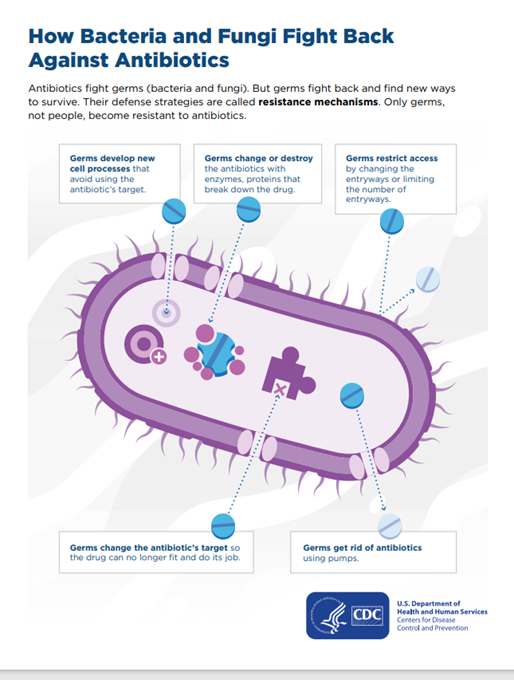Antimicrobial Resistance – the escalating global threat
Srilekha Deka, MD, PhD. March 8, 2023.
Introduction
Antimicrobial resistance is a global public health threat. Antimicrobial resistance (AMR) refers to the ability of microorganisms, such as bacteria, viruses, fungi, and parasites, to resist the effects of antimicrobial drugs that were previously effective in treating infections. AMR resulted in approximately 5 million deaths in 2019 and killed nearly 1.27 million people worldwide. As per CDC’s 2019 Antibiotic Resistance (AR) Threats Report1, more than 2.8 million antimicrobial resistant infections occur each year resulting in greater than 35,000 deaths. If we add Clostridioides difficile 2, a bacterium causing deadly diarrhea associated with antimicrobial use, to this count, the death toll exceeds 48,000 and the threat of antimicrobial resistant infections is greater than 3 million.

Adapted from Antibiotic Resistance Threats in the United States, 2019 (cdc.gov)3
AMR is a one of the world’s most urgent public health problems that can lead to the failure of treatment of infectious diseases, increased healthcare costs, and higher mortality rates. The overuse and misuse of antibiotics in humans and animals are major contributing factors to the development and spread of AMR.

Adapted from How Antibiotic Resistance Spreads (cdc.gov)4
Development and Spread of Antimicrobial Resistance
For an organism to cause a dangerous infection, it does not need to be resistant to every antibiotic or antifungal. When bacteria and fungi develop resistance to even a single antibiotic or antifungal, they can cause serious problems. As medical science advances in the fields of joint replacements, organ transplants and cancer therapy, we depend on antimicrobials to be able to perform their function robustly. In case of chronic diseases like diabetes, asthma or other conditions which put patients at increased risk of infections, we depend on antimicrobials to be effective. In addition, failure to effectively treat an infection using the first line of treatment due to antimicrobial resistance leads to use of second- and third-line treatments which could not only cause serious side-effects and prolong the disease state but also puts an economic burden on the patient and the healthcare system. At the other end of the spectrum, in certain situations, these infections do not have a second- or third-line treatment option.
Antimicrobial resistance (AMR) happens due to a combination of genetic, environmental, and behavioral factors when microorganisms develop the ability to defeat the drugs designed to kill them.

Adapted from How Bacteria and Fungi Fight Back Against Antibiotics (cdc.gov)5
Some key factors that can contribute to the development and spread of AMR include:
- Overuse and misuse of antimicrobial drugs: Antimicrobial drugs are designed to kill bacteria and fungi. When antimicrobial drugs are used too often or inappropriately, they can kill susceptible bacteria, but a subset develop defense strategies leading to the generation of resistant bacteria that can grow and multiply in the presence of that antimicrobial.
- Poor infection prevention and control: Inadequate hygiene practices, poor sanitation, and inadequate infection prevention and control measures in healthcare settings can facilitate the spread of resistant bacteria and other microorganisms.
- Lack of new antimicrobial drugs: The development of new antimicrobial drugs has slowed down in recent years, leaving us with a limited number of effective drugs to treat infections caused by resistant microorganisms.
- Global travel and trade: The movement of people and goods across borders can facilitate the spread of resistant microorganisms between countries and regions.
- Agricultural practices: The use of antimicrobial drugs in animal agriculture can contribute to the development and spread of resistant bacteria.
All these factors, in isolation or in combination, lead to development of resistant strains of microorganisms that are difficult or impossible to treat with existing drugs. Additionally, microorganisms can share their resistance-mechanisms with other microorganisms that have not been exposed to antibiotics or antifungals. With the right combination of resistance mechanisms, we can end up with superbugs.

Adapted from How Antibiotic Resistance Moves Directly Germ to Germ (cdc.gov)6
Summary
Superbugs are bacteria that are resistant to multiple antimicrobial drugs, making these infections difficult or impossible to treat using standard antibiotics. These bacteria are a major public health concern because they can cause serious infections and can lead to higher rates of morbidity and mortality.
Superbugs typically develop through the process of natural selection. When bacteria are exposed to antimicrobial drugs, genetic mutations are sometimes generated that allow them to survive and multiply despite the presence of the antimicrobial drug. These resistant bacteria can become more prevalent and can now spread to other individuals thereby, magnifying the problem. One of these superbugs that become a major problem, especially as a healthcare-associated infection, is methicillin-resistant Staphylococcus aureus (MRSA). MRSA shows resistance to many first-line antibiotics and can cause skin and soft tissue infections, pneumonia, and sepsis. Another one of note is the carbapenem-resistant Enterobacteriaceae (CRE), which is resistant to most first-line antibiotics and can cause infections in the bloodstream, urinary tract, and other parts of the body.
In order to address AMR and the threat of superbugs, it is important to adopt a comprehensive approach that includes appropriate use of antimicrobial drugs, improved infection prevention and control, development of new drugs, and education and awareness campaigns for healthcare professionals and the general public. If antibiotics and antifungals lose their effectiveness, then we lose the ability to treat infections and control these public health threats.
References
2. C. diff (Clostridioides difficile) | CDC
3. Antibiotic Resistance Threats in the United States, 2019 (cdc.gov)
4. How Antibiotic Resistance Spreads (cdc.gov)
5. How Bacteria and Fungi Fight Back Against Antibiotics (cdc.gov)
6. How Antibiotic Resistance Moves Directly Germ to Germ (cdc.gov)

